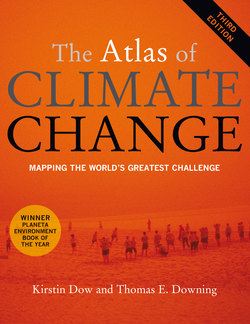Читать книгу The Atlas of Climate Change - Professor Kirstin Dow - Страница 17
На сайте Литреса книга снята с продажи.
Оглавлениеcomparable time periods.” This Atlas generally follows the UNFCCC’s distinction between “climate change” attributable to human activities altering the atmospheric composition, and “climate variability” attributable to natural causes. Although often used to mean climate change, global warming is only one aspect of this – the increase in global mean temperature. COP Conference of Parties to the UNFCCC. Coral bleaching The paling in color of corals resulting from a loss of symbiotic algae, in response to abrupt changes in temperature, salinity, and turbidity. Cryosphere Component of the climate system consisting of all snow, ice, and permafrost on and beneath the surface of the earth and ocean. Ecosystem A system of interacting living organisms together with their physical environment, which can range from very small areas to the entire Earth. El Niño/Southern Oscillation A climate pattern characterized by variations in the temperature of the surface of the tropical eastern Pacific Ocean (warming or cooling, known as El Niño and La Niña respectively) and air surface pressure in the tropical western Pacific (the Southern Oscillation). Occurs roughly every five years. Emissions Reduction Units Equal to 1 tonne of carbon dioxide emissions reduced or sequestered arising from a Joint Implementation (defined in Article 6 of the Kyoto Protocol) project calculated using the global warming potential (GWP). Fugitive emissions Intentional or unintentional releases of gases from anthropogenic activities such as the processing, transmission or transportation of gas or petroleum. Geothermal Literal meaning: “Earth” plus “heat”. To produce electric power from geothermal resources, heat from underground sources is tapped by wells and the steam fed through turbines. Glacier A mass of land ice flowing downhill. A glacier is maintained by accumulation of snow at high altitudes, balanced by melting at low altitudes or discharge into the sea. Global warming Increase in global mean temperature. Global warming potential (GWP) An index, describing the radiative characteristics of well-mixed greenhouse gases, that represents the combined effect of the differing times these gases remain in the atmosphere and their relative effectiveness in absorbing outgoing long-wave radiation. The GWP of carbon dioxide is 1. Greenhouse gas Gases in the atmosphere, both natural and anthropogenic, that absorb and emit radiation at specific wavelengths within the spectrum of long-wave radiation emitted by the Earth’s surface, the atmosphere, and clouds. This property causes the greenhouse effect. Water vapor (H2O), carbon dioxide (CO2), nitrous oxide (N2O), methane (CH4), and ozone (O3) are the primary greenhouse gases in the Earth’s atmosphere, but there are a number of entirely human-made greenhouse gases, such as the halocarbons and other chlorine- and bromine-containing substances, dealt with under the Montreal Protocol. Gridded data The result of converting scattered individual data points into a regular grid of calculated, hypothetical values. Also known as “raster data”. Ice sheet A mass of land ice that is sufficiently deep to cover most of the underlying bedrock topography. There are only two large ice sheets in the modern world, on Greenland and Antarctica. Ice shelf A floating ice sheet of considerable thickness attached to a coast (usually of great horizontal extent with a level or gently undulating surface); often a seaward extension of ice sheets. ICT Information and communications technology. IPCC Intergovernmental Panel on Climate Change. Established by the World Meteorological Organization (WMO) and the United Nations Environment Programme (UNEP) in 1988 to assess scientific, technical and socio-economic information relevant to the understanding of climate change, its potential impacts and options for adaptation and mitigation. The IPCC Fifth Assessment Report (AR5) is scheduled for release in 2013/2014, based on the results of three working groups involved in assessing the scientific basis, the impacts, adaptations and vulnerabilities, and the mitigation of climate change. JI Joint Implementation, a market-based implementation mechanism defined in Article 6 of the Kyoto Protocol, allowing Annex I countries or companies from these countries to implement projects jointly that limit or reduce emissions, or enhance sinks, and to share the Emissions Reduction Units. JI activity is also permitted in Article 4.2(a) of the UNFCCC. Kyoto Protocol to the United Nations Framework Convention on Climate Change (UNFCCC), adopted at the Third Session of the Conference of the Parties to the UNFCCC in 1997 in Kyoto, Japan. It contains legally binding commitments, in addition to those included in the UNFCCC. Countries included in Annex B of the Protocol (most countries in the Organisation for Economic Cooperation and Development, and countries with economies in transition) agreed to reduce their anthropogenic greenhouse gas emissions by at least
17
